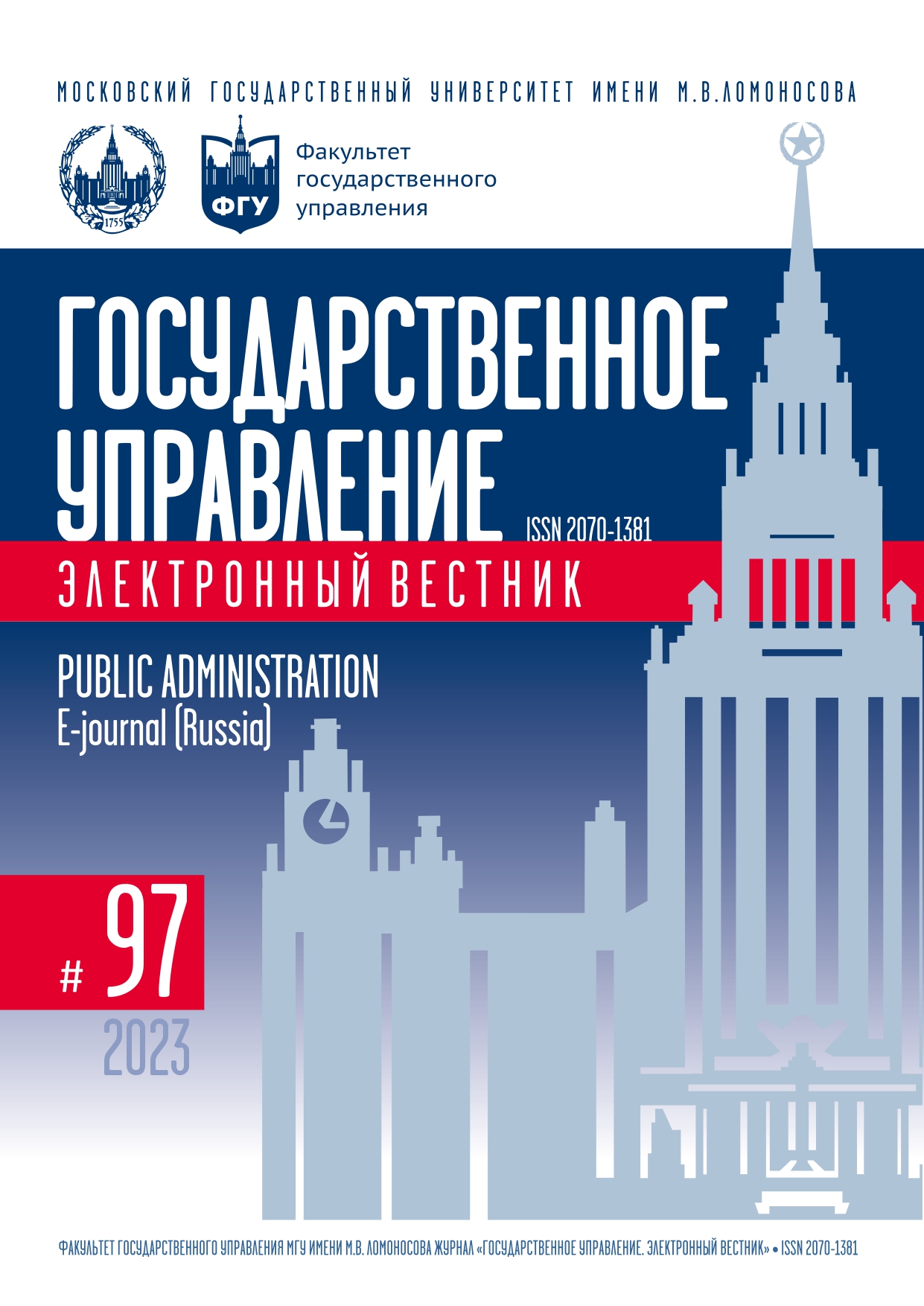Neurointerfaces in Public Administration: Opportunities and Limitations
Keywords:
Neurotechnologies, neurointerface, neurocommunications, neurosensing, neuro discrimination, neurosecurityAbstract
The study of the modern nomenclature of neurointerfaces is aimed at determining the technological horizons of the transformation of public administration, while it becomes particularly relevant in connection with the adoption of the roadmap for the development of “end-to-end” digital technology “Neurotechnologies and Artificial Intelligence”. Close attention to the development of neurotechnologies reflects the desire of the Russian Federation Government to respond qualitatively to the growth of the global market of neurointerfaces and on a sovereign technological basis to make an innovative transition to a new system of man-machine interaction, providing civil servants with the opportunity to perform administrative operations more efficiently. In this regard, the aim of the study is to reveal and visualize technical capabilities and limitations, potential risks from the introduction of neural interfaces into public administration practice. Taking into account the growth of software and technical solutions based on neurotechnologies, research methods include a cognitive method evaluating technological methods of application and likely negative consequences from the introduction of neurotechnologies, a method for visualizing mechanisms and technologies for the introduction of neurotechnologies both at the level of software solutions and at the technological level of neurointerfaces, a method of expert survey of representatives of the academic community of Russia using Google-tables. The results of the study suggest that, with all the diversity of the development of neurotechnologies in the field of public administration, computer vision technologies for identification and verification of personality, technologies of intelligent analysis and speech synthesis, technologies of recommendation systems and the creation of virtual assistants, technologies of machine learning, technologies of neuromanagement of communications and human motor activity, technologies of neurotracking, cognitive enhancement and the creation of mixed human-machine teams can be successfully implemented in the coming years. The potential negative consequences of the introduction of neurotechnologies into the practice of public administration determine the directions for further research of neurointerfaces related to issues of ensuring neuropsecurity, protection against neurodiscrimination and algorithmic bias, forecasting the effects of neurostimulation and cognitive improvement, preserving the neuropsychic integrity of a person and the integrity of his/her neurological profile.
References
Бодин О.Н., Солодимова Г.А., Спиркин А.Н. Нейроинтерфейс для управления роботизированными устройствами // Измерение. Мониторинг. Управление. Контроль. 2019. № 4 (30). С. 70–76. DOI: 10.21685/2307-5538-2019-4-8
Ганин И.П., Каплан А.Я. Изучение эффектов вариативности потенциалов мозга человека в интерфейсе мозг-компьютер на волне Р300 // Вестник Российского государственного медицинского университета. 2022. № 3. С. 78–85. DOI: 10.24075/vrgmu.2022.033
Данилевский В.Я. Исследования над физиологическим действием электричества на расстоянии. Том 2. Дальнейшие опыты по нейро-электрокинезу. Харьков: Паровая Типо-Литография М. Зильбергеръ и С-вья, 1901
Кравченко С.В., Каде А.Х., Трофименко А.И., Вчерашнюк С.П., Малышко В.В. Когнитивное нейропротезирование — путь от эксперимента к клиническому применению // Инновационная медицина Кубани. 2021. № 3. С. 64–72. DOI: 10.35401/2500-0268-2021-23-3-64-72
Миронов В.И., Лобов С.А., Крылова Н.П., Гордлеева C.Ю., Каплан А.Я., Буйлова Т.В., Бахшиев А.Б., Щуровский Д.В., Вагнер В.О., Кастальский И.А., Ли А.Н., Казанцев В.Б. Разработка нейроуправляемого автомобиля для мобилизации людей с двигательным дефицитом — нейромобиля // Современные технологии в медицине. 2018. Т. 10. № 4. С. 49–59. DOI: 10.17691/stm2018.10.4.06
Сеченов И.М. Рефлексы головного мозга // Медицинский вестник. 1863. № 47. C. 461–484; № 48. C. 493–512.
Спешилова Н.В., Андриенко Д.А., Рахматуллин Р.Р., Спешилов Е.А. Анализ и оценка горизонтов применения технологии нейроинтерфейса при реализации концепции «Индустрия 4.0» в конкурирующем мировом экономическом пространстве // Вестник Евразийской науки. 2019. № 2. URL: https://esj.today/52ecvn219.html
Филипова И.А. Нейротехнологии: развитие, применение на практике и правовое регулирование // Вестник СПбГУ. Право. 2021. Т. 12. № 3. С. 502–521. DOI: 10.21638/spbu14.2021.302
Филипов И.А. Нейротехнологии в праве и правоприменении: прошлое, настоящее и будущее // Правоприменение. 2022. Т. 6. № 2. С. 32–49. DOI: 10.52468/2542-1514.2022.6(2).32-49
Berger H. Über das Elektroenzephalogramm des Menschen // Archiv für Psychiatrie und Nervenkrankheiten. 1929. Bd. 87. № 1. S. 527–570.
Bryndin E. Communication of Internal Speech with Communicative Associative Robot via Spectral Neurointerface // Electrical Science and Engineering. 2021. Vol. 3. Is. 1. P. 16–22. DOI: 10.30564/ese.v3i1.3255
Caton R. Electrical Currents of the Brain // The Chicago Journal of Nervous and Mental Disease. 1875. Vol. 4. Is. 2. P. 610.
Cinel C., Valeriani D., Poli R. Neurotechnologies for Human Cognitive Augmentation: Current State of the Art and Future Prospects // Frontiers in Human Neuroscience. 2019. Vol. 13. DOI: 10.3389/fnhum.2019.00013
Delgado J. Physical Control of the Mind: Toward a Psychocivilized Society. New York: Harper & Row, 1969.
Gao X., Wang Y., Chen X., Gao S. Interface, Interaction, and Intelligence in Generalized Brain–Computer Interfaces // Trends in Cognitive Sciences. 2021. Vol. 25. Is. 8. P. 671–684. DOI: 10.1016/j.tics.2021.04.003
Kennedy P., Bakay R. Restoration of Neural Output from a Paralyzed Patient by a Direct Brain Connection // Neuroreport, 1998. Vol. 9. Is. 8. P. 1707–1711. DOI: 0.1097/00001756-199806010-00007
Ma Q., Gao W., Xiao Q., Ding L., Gao T., Zhou Y., Gao X., Yan Y., Liu Ch., Gu Z., Kong X., Abbasi Q.H., Li L., Qiu Cg-W., Li Y., Cui T.J. Directly Wireless Communication of Human Minds via Non-Invasive Brain-Computer-Metasurface Platform // eLight. 2022. Vol. 2.
DOI: 10.1186/s43593-022-00019-x
Nemminski W.W. Ein Versuch der Registrierung der elektrischen Gehirnerscheinungen // Zentralblatt für Physiologie. 1913. Bd. XXVII. S. 951–960.
Reymond E. Reden von Emil Du Bois-Reymond. Leipzig: Verlag von Veit and Comp., 1912.
Tzovara A., Chavarriaga R., De Lucia M. Quantifying the Time for Accurate EEG Decoding of Single Value-Based Decisions // Journal of Neuroscience Methods. 2015. Vol. 250. P. 114–125. DOI: 10.1016/j.jneumeth.2014.09.029
Valeriani D., Cinel C., Poli R. Group Augmentation in Realistic Visual-Search Decisions via a Hybrid Brain-Computer Interface // Scientific Reports. 2017. Vol. 7. DOI: 10.1038/s41598-017-08265-7

